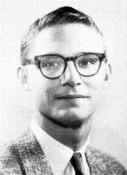|

Arthur J. Quinn , Rhetoric: Berkeley
Professor Arthur J. Quinn died at his home in Berkeley on Thursday, May 15, 1997, after a long illness. He was 54 years old. A third-generation Californian, Quinn was a native of Marin County, born on September 18, 1942, in San Rafael. After graduating from Marin Catholic High School, he studied at the University of San Francisco, where he also played baseball, and then at Princeton University, which awarded him a Ph.D. in the History and Philosophy of Science in 1970. He never lost his early love for sports, and he would occasionally, at a difficult moment, regret having refused a contract to play professional baseball.
Quinn began his teaching career at the University of Oregon in 1968 and moved in 1970 to Berkeley, where he taught until his death. His service in the Rhetoric Department was marked by his leading role in the reorganization of the undergraduate major and by terms as chair of the department and as director of college writing. Quinn held the University's Distinguished Teaching Award and enjoyed a broad reputation as one of the outstanding teachers in the humanities. He was particularly known for his efforts to encourage good writing and for the very wide range of authors he taught, ranging from the Bible to Henry Adams and Simone Weil.
Among the many honors that came to him were Woodrow Wilson, National Science Foundation, and Danforth fellowships, and Award of Merit from the California Historical Society, and a fellowship of Clare Hall, Cambridge, England, where he was living with his family when he fell ill. He was a member of PEN, the international writers' association.
Quinn published books on many subjects, from the Old Testament and British philosophy to rhetoric and history. One of his books on rhetoric, Figures of Speech (1982), drew praise from scholars and was chosen as an alternate selection by the Book of the Month Club. His greatest love, however, was the history of the United States, especially his native California. He wrote three books on California history: The Broken Shore (1981) recapitulates great themes of Western Civilization within a history of what is now Marin County; The Rivals (1994) narrates struggles for justice and order in early American San Francisco and California on the eve of the Civil War; and Hell With the Fire Out (1997) recreates from eyewitness accounts the grim story of the Modoc War.
Quinn's creation narratives of California found their macrocosmic framework in the prehistory and early history of the American Republic. In his masterwork, A New World: An Epic of Colonial America from the Founding of Jamestown to the Fall of Quebec (1994), he tells how the Europeans re-enacted their social, political, and religious heritages in North American settings. In his introductory evocation of Virgil, he posed his essential question:
"Does history require such viciousness for so noble an end? If so, then the forces that govern it are perverse. And the free and prosperous American republic that would eventually emerge from this tumultuous process of colonization was itself little more than a Pyrrhic victory for the human spirit."
From his earliest writings, Quinn believed that history involved "the strenuous determination of moral questions," which made it "a humanistic discipline, perhaps even the humanistic discipline par excellence."
He was a philosophical historian in the tradition of Edward Gibbon and Henry Adams, both of whom he surpassed in stylistic range but also in breadth of moral vision. Upon the appearance of his first book on California, Czeslaw Milosz, Berkeley's Nobel poet laureate, referred to Art as "the Ecclesiastes of the West Coast."
Art Quinn is survived by his wife, Barney Roddy Quinn, a native of Ross, and four children, Edward, Mary, Joseph, and Elizabeth, all of Berkeley.
Courtesy of Thomas A. Brady Jr. Robert Middlekauff Leonard Nathan Thomas Sloane
|
Tom O'Doul
Art was the best and smartest member in the class of 1960.What a loss to have him die so young. To Barney and his children, I give my love. Tom
Suzanne Helms (Yanok)
From GLENN CHEETHAM to S.H.Y.: "Our families rented two cabins up at Forest Lake (near Hoberg's) one year. There were 3 together on a knoll. A stranger was staying by himself in one all summer. Naturally we got to know him a little even though he kept to himself. Turned out it was Charles Schulz of Peanuts fame and he was drawing the cartoons and painting. Great artist."Elvis was big and Art had two pairs of swede shoes, one pink and one purple. We took turns wearing them to the nightly dances under the stars. Big hit with the girls...Too many stories and too little time."
Glenn Cheetham